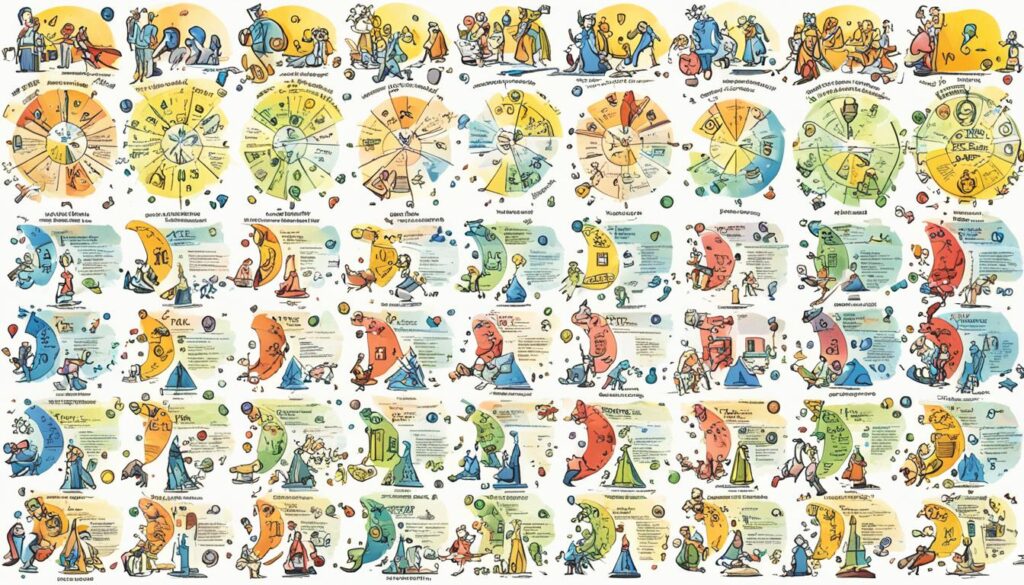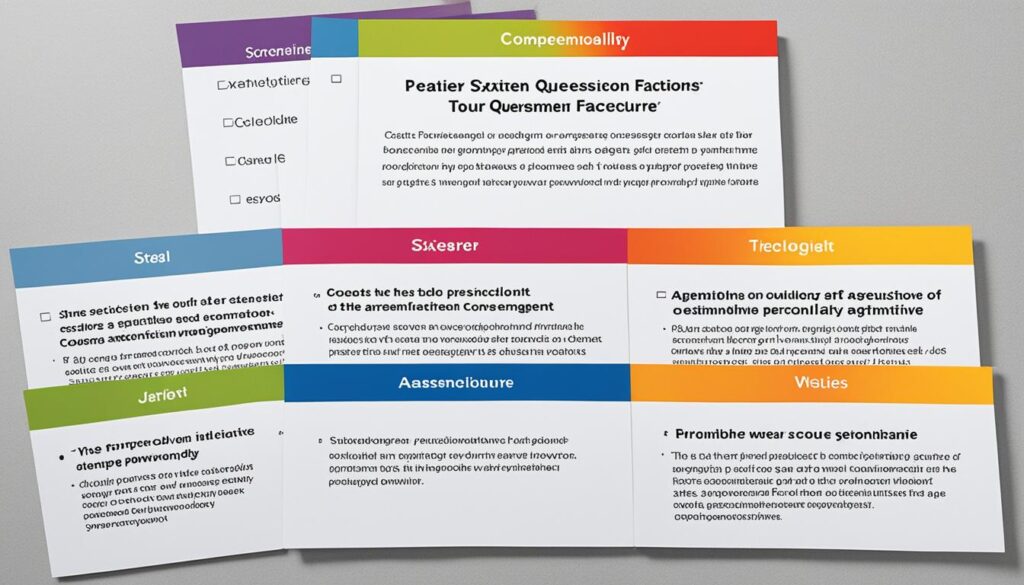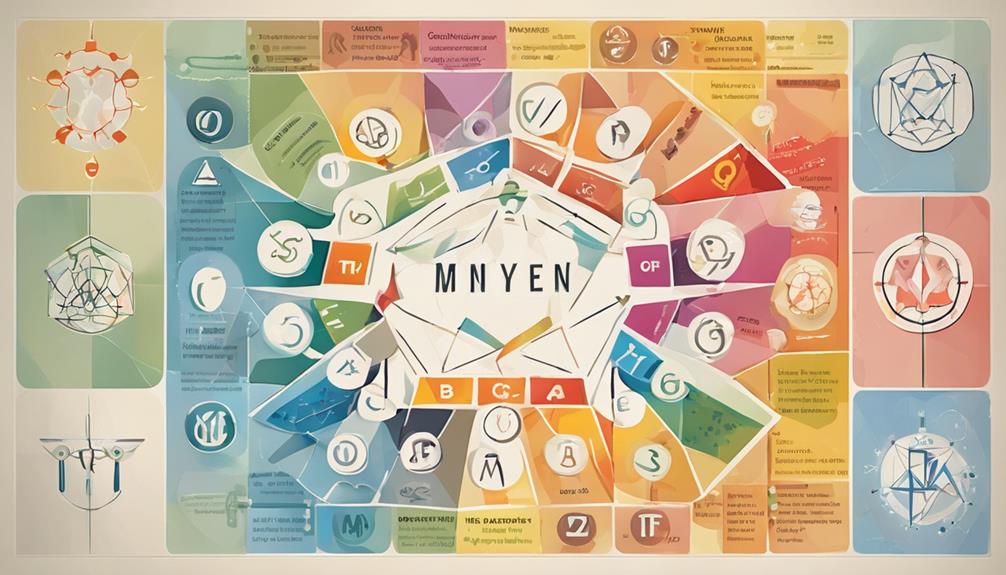Have you ever thought about the fact that every person needs the best communication and understanding? Statistics show that there are more than 7 billion people in the world and each person has a unique personality. In this largest population in history, do we need a tool for better self-awareness and understanding of ourselves and others?
آزمون شخصیت شناسی شانزده گانه، یک آزمون روانسنجی است که براساس مدل MBTI و نظریهی یونگ طراحی شده است. این آزمون به ما کمک میکند تا شخصیت و نقاط قوت خود را بهتر بشناسیم و بهترین روشها برای موفقیت در زندگی شغلی و پیشرفت در روابط را درک کنیم. با شرکت در آزمون، افراد به یکی از شانزده نوع شخصیتی تعلق میگیرند که ویژگیها و ترجیحات منحصر به فردی دارد.
آیا شما هم علاقهمندید که بیشتر درباره آزمون شخصیت شناسی شانزده گانه بدانید؟ ادامه مطلب را بخوانید و بیشتر درباره اهمیت آن، تاریخچه، نوعهای شخصیتی و کاربردهایش بدانید.
نکات کلیدی:
- آزمون شخصیت شناسی شانزده گانه بر پایه مدل MBTI و نظریه یونگ طراحی شده است.
- شرکت در این آزمون به ما کمک میکند تا شخصیت و نقاط قوت خود را بشناسیم.
- افراد به یکی از شانزده نوع شخصیتی تعلق میگیرند و ویژگیهای منحصر به فردی دارند.
- آزمون شخصیت شناسی شانزده گانه در زندگی شخصی و شغلی اهمیت بسیاری دارد.
- کاربردهای آزمون شامل استخدام، تیمبندی، رشد شخصی و بهبود مهارتهای ارتباطی است.
تاریخچه آزمون شخصیت شناسی شانزده گانه
آزمون شخصیت شناسی شانزده گانه توسط ایزابل مایرز و کاترین بریگز بر اساس تئوری کارل یونگ در دهه ۱۹۴۰ ایجاد شد. این آزمون بر مبنای ترجیحات شخصیتی فرد، ویژگیها، واکنشها و ترجیحات شغلی و روابط طراحی شده است. مایرز و بریگز به منظور کمک به افراد در انتخاب شغل و زندگی بهتر، این آزمون را طراحی کردند. این آزمون یکی از معتبرترین و پرکاربردترین آزمونهای شخصیت شناسی در دنیا است و توسط محققان، مشاوران و سازمانها به عنوان ابزاری مفید برای شناسایی نوع شخصیت و تقویت روابط استفاده میشود.

| تاریخچه | آزمون شخصیت شناسی شانزده گانه |
|---|---|
| تئوری مبتنی بر | کارل یونگ |
| طراحان | ایزابل مایرز و کاترین بریگز |
| اهمیت | کمک به افراد در انتخاب شغل و زندگی بهتر |
| ویژگیها | ترجیحات شخصیتی، ویژگیها، واکنشها و ترجیحات شغلی و روابط |
استفاده از آزمون شخصیت شناسی شانزده گانه میتواند در شناسایی نوع شخصیتی و بهبود روابط شخصی و حرفهای کمک کند و به توسعه فردی و رشد سازمانی کمک کند.
اهمیت آزمون شخصیت شناسی شانزده گانه
آزمون شخصیت شناسی شانزده گانه اهمیت بسیاری در شناخت بهتر از خود و دیگران دارد. با شناخت نوع شخصیت خود، میتوانید بهترین راهها برای ارتباطات، کارآمدی، خلاقیت و تعامل با دیگران را پیدا کنید.
در محیط کاری، آشنایی با شخصیت همکاران و رؤیای کاری آنها میتواند به بهبود همکاری و ارتباطات در سازمان کمک کند. این آزمون میتواند به عنوان یک ابزار ارزشمند در استخدام، توسعه فردی و رشد سازمانی استفاده شود.

شناخت خود و دیگران
آزمون شخصیت شناسی شانزده گانه به شما این امکان را میدهد که با صحیحترین شکل ممکن از خود و دیگران آگاه شوید. با شناخت نوع شخصیتی خود و مشاهده واکنشها، علاقهمندیها و ترجیحات شخصیتی خود میتوانید به بهبود روابط شخصی و حرفهای خود بپردازید و رشد کنید.
ارتباطات و کارآمدی
شناخت شخصیت خود و دیگران میتواند به شما در ارتباطات خود و با دیگران کمک کند. با شناخت ترجیحات و نحوهی اندیشیدن و عملکرد دیگران، میتوانید بهترین روشها برای برقراری ارتباط موثر و کارآمد با آنها را پیدا کنید.
خلاقیت و تعامل
شناخت نوع شخصیتی خود میتواند به شما در بهبود خلاقیت و تعامل با دیگران کمک کند. با شناخت نقاط قوت و ضعف خود، میتوانید در فعالیتهای خلاقانه بیشتر به خود اعتماد کنید و در تعاملات روزمره با دیگران موفقیت بیشتری داشته باشید.
نوعهای شخصیتی در آزمون شخصیت شناسی شانزده گانه
آزمون شخصیت شناسی شانزده گانه به افراد کمک میکند تا به یکی از شانزده نوع شخصیتی تعلق پیدا کنند. این نوعهای شخصیتی شامل INFJ، INTJ، ENFP، ENTP، INFP، ISFP، ENFJ، ESFJ، INTP، ISTP، ENTJ، ESTJ، ISFJ، ISTJ، ESFP، و ESTP میشوند. هر نوع شخصیتی ویژگیها، سبکهای تفکر و عملکرد، علاقهمندیها و روش کاری منحصر به فردی دارد.
| نوع شخصیتی | ویژگیها | سبکهای تفکر و عملکرد | علاقهمندیها | روش کاری |
|---|---|---|---|---|
| INFJ | تاملگر، خلاق و باطنی | تفکر عمیق، برنامهریزی، تأمل | بهبود جهان، کمک به دیگران، خلاقیت | سازماندهی، برنامهریزی، همکاری |
| INTJ | مستقل، منطقی و بینشی | تحلیل دقیق، برنامهریزی استراتژیک، نظم و انضباط | حل مسئله، تحلیل، آفرینش | تحقیق، شناسایی الگوها، ساختاردهی |
| ENFP | همدرد، خلاق و پرانرژی | اندیشه پراکنده، ارتباطات بهتر و خلاقیت | کشف جهان، کمک به دیگران، خلاقیت | نوآوری، شناسایی فرصتها، نقشهبرداری |
| ENTP | خلاق، مبادلهگر و پرانرژی | تحلیل پویا، ایدهپردازی، چالش پذیری | کشف جهان، آزادی عمل، حل مسئله | حل مسئله، آزمایش فرضیهها، ارتباطات |
هر یک از این نوعهای شخصیتی تعدادی ویژگی مشخص دارد و به روشهای خاصی در فكركرد، برخورداری، علاقهمندیها و روشهای کاری دست مییابند. شناخت نوع شخصیتی خود و دیگران میتواند در تفاهم بهتر، ارتباطات موثرتر و رشد فردی و حرفهای کمک شایانی کند.
چگونگی انجام آزمون شخصیت شناسی شانزده گانه
برای انجام آزمون شخصیت شناسی شانزده گانه، شما باید سوالاتی را پاسخ دهید که بر اساس ترجیحات شما و واکنشهایی که در موقعیتهای مختلف دارید، طراحی شدهاند. این آزمون معمولاً در حدود ۱۵ دقیقه طول میکشد و میتوانید به صورت آنلاین آن را انجام دهید. نتیجه آزمون به شما نوع شخصیتی خود و ویژگیها و ترجیحات تان را نشان میدهد.

آزمون شخصیت شناسی شانزده گانه با سوالاتی که از شما پرسیده میشود، تمام جنبههای شخصیتی شما را بررسی میکند. به ازای هر سوال، شما باید بر اساس واکنشها و ترجیحات خود پاسخ دهید. پاسخهای شما به این سوالات نشان میدهد که در موقعیتهای مختلف چگونه با رفتارها و ترجیحات واکنش میدهید.
دستههای مختلف سوالات در آزمون شخصیت شناسی شانزده گانه وجود دارد که هر کدام به ترجیحات شما در زمینههای مختلف مانند شغل، روابط، ارتباطات و سبکهای تفکر مرتبط است. با تجمیع پاسخهای شما، آزمون نوع شخصیتی و مشخصههای خاصی را برای شما تعیین میکند.
برای انجام آزمون میتوانید از منابع آنلاین استفاده کنید. آزمون شخصیت شناسی شانزده گانه به طور گسترده از طرفان مختلف استفاده میشود، بنابراین منابع معتبر آن بسیار موجود هستند. پس از اتمام آزمون، شما به نتیجه خود دست خواهید یافت و اطلاعاتی درباره شخصیت خود به دست خواهید آورد که میتوانید آنها را در زندگی شخصی و شغلی خود استفاده کنید.
کاربردهای آزمون شخصیت شناسی شانزده گانه
آزمون شخصیت شناسی شانزده گانه قابل استفاده در مختلف زمینهها و کاربردها است. این آزمون میتواند در انتخاب شغل و استخدام مفید باشد. با شناخت نوع شخصیت خود و ترجیحات شغلیتان، میتوانید بهترین شغل و محیط کاری برای خود را پیدا کنید. همچنین، آزمون شخصیت شناسی شانزده گانه به شما کمک میکند تا مهارتهای تیمی و همکاری را در محیط کاری بهبود بخشید. این آزمون همچنین امکان رشد شخصی و توسعه فردی را فراهم میکند، زیرا با شناخت بهتر از خود، میتوانید به موفقیتهای بیشتری دست یابید.
در ضمن، آزمون شخصیت شناسی شانزده گانه میتواند به شما بهترین راههای ارتباطی و مدیریت روابط را نشان دهد. با شناخت نوع شخصیت و شناخت مهارتهای ارتباطی خود، میتوانید بهترین روشها برای برقراری ارتباط با دیگران و بهبود روابط فردیتان را پیدا کنید. همچنین، آزمون شخصیت شناسی شانزده گانه میتواند به بهبود مهارتهای رهبری کمک کند. با شناخت و درک بهتر از شخصیت خود، میتوانید بهترین راهها برای رهبری موثر و برنامهریزی زندگی خود را پیدا کنید.
«آزمون شخصیت شناسی شانزده گانه در انتخاب شغل، تیمبندی، توسعه فردی و مدیریت روابط بسیار کارآمد است. این آزمون میتواند به شما کمک کند تا بهترین راهها را برای رسیدن به موفقیت در زندگی شخصی و شغلیتان پیدا کنید.»

استخدام و انتخاب شغل
آزمون شخصیت شناسی شانزده گانه میتواند در مراحل استخدام و انتخاب شغل بسیار مفید باشد. با شناخت نوع شخصیت خود و ترجیحات شغلیتان، میتوانید بهترین شغل و محیط کاری برای خود را پیدا کنید. همچنین، با توجه به نوع شخصیت خود، میتوانید بر اساس ویژگیها و ترجیحاتتان، مهارتهای لازم برای شغل خود را توسعه دهید و در مسیر رشد حرفهایتان پیش بروید.
تیمبندی و همکاری در محیط کاری
آزمون شخصیت شناسی شانزده گانه قابل استفاده در تیمبندی و همکاری در محیط کاری است. با شناخت نوع شخصیت و شخصیتهای همکارانتان، میتوانید بهترین روشها را برای همکاری و ارتباط با افراد دیگر پیدا کنید. همچنین، با توجه به نوع شخصیت خود و همکاران، میتوانید مناسبترین روشها برای تشکیل گروه و تیمبندی را انتخاب کرده و همکاری موثری را در محیط کاری ایجاد کنید.
رشد شخصی و توسعه فردی
آزمون شخصیت شناسی شانزده گانه میتواند به شما در رشد شخصی و توسعه فردی کمک کند. با شناخت نوع شخصیت و ویژگیها و تمایلات خود، میتوانید بهترین راهها را برای توسعه شخصی و بهبود مهارتها و قابلیتهایتان پیدا کنید. همچنین، با شناخت نقاط قوت و ضعف خود میتوانید به پیشرفت و بهبود کیفیت زندگی شخصیتان دست یابید.
بهترین روشهای ارتباط و مدیریت روابط
با شناخت نوع شخصیت خود و نوع شخصیت دیگران، میتوانید بهترین روشها برای برقراری ارتباط با دیگران و مدیریت روابط را پیدا کنید. با توجه به ویژگیها و ترجیحات شخصیتی خود و دیگران، میتوانید روشهای مؤثری برای ارتباط مؤثر، حل مشکلات و مدیریت روابط فردیتان را بیابید. همچنین، با شناخت بهتر از خود و دیگران، میتوانید در مسیر رسیدن به اهداف شخصی و حرفهای خود به بهترین روش ممکن پیش بروید.
تعامل با دیگران
آزمون شخصیت شناسی شانزده گانه به شما کمک میکند تا بهترین راهها را برای تعامل با دیگران پیدا کنید. با شناخت نوع شخصیت خود و تفاوتهای شخصیتی با افراد دیگر، میتوانید روشهای مؤثری برای برقراری ارتباط، احترامگذاری به مرزهای شخصیتی و حفظ روابط موثر با دیگران بیابید. همچنین، با شناخت بهتر از تمایلات و نیازهای دیگران، میتوانید بهترین روشها برای کمک به آنها و تحقق هدف مشترک را پیدا کنید.
بهبود مهارتهای رهبری و برنامهریزی زندگی
آزمون شخصیت شناسی شانزده گانه میتواند به شما کمک کند تا مهارتهای رهبری و برنامهریزی زندگی خود را بهبود بخشید. با شناخت نوع شخصیت خود و ویژگیهای شخصیتی خود، میتوانید بهترین راهها را برای موفقیت در نقش رهبری و برنامهریزی زندگیتان پیدا کنید. همچنین، با توجه به نوع شخصیت و تفاوتهای شخصیتی با افراد دیگر، میتوانید روشهای مؤثری برای مدیریت زمان، تعیین اولویتها و دستیابی به اهدافتان پیدا کنید.
فواید شناخت شخصیت در زندگی شخصی و شغلی
فهم و شناخت صحیح از شخصیت خود، به شما کمک میکند تا ارتباطات بهتری برقرار کنید، روابط شخصی و حرفهای بهبود یابد، مهارتهای ارتباطی و مدیریت روابط فردیتان را بهبود بخشید و بهترین راهها برای رسیدن به موفقیت در زندگی شخصی و شغلی را پیدا کنید. شناخت خود و دیگران در سازمانها و تیمهای کاری نقش بسزایی در حل مسائل و کارآیی دارد و میتواند به رشد و پیشرفت شغلی شما کمک کند.
با شناخت شخصیت خود، میتوانید:
- بهبود ارتباطات: شناخت صحیح از شخصیت خود به شما کمک میکند تا در مواجهه با دیگران، راههای بهتری برای ارتباط برقرار کنید. با درک نیازها و تمایلات شخصیتی افراد، میتوانید بهترین روشها را برای برقراری ارتباط موثر و موفقیتآمیز با همکاران، دوستان و خانواده پیدا کنید.
- ارتقای روابط شخصی و حرفهای: با شناخت خود و دیگران، میتوانید روابط شخصی و حرفهای خود را بهبود بخشید. با درک صحیح از نیازها، ترجیحات و فرهنگ فرد دیگر، میتوانید روابط را بر اساس احترام، تعاون و فهم مشترک، به سمت رشد و تقویت هدایت کنید.
- توسعه مهارتهای ارتباطی و مدیریت روابط: با شناخت خود و دیگران، میتوانید بهبود مهارتهای ارتباطی خود را تحقق بخشید و بهترین راهها را برای مدیریت روابط با همکاران، مشتریان، و سایر افراد در زندگی شخصی و مهنی پیدا کنید. این مهارتها شامل شناخت نحوه برقراری ارتباط، مهارتهای گفتگو، گوش کردن فعال، قدرت تفکر استراتژیک و حل مسائل در روابط است.
همچنین، شناخت شخصیت خود و دیگران در زمان و منابع سازمانی نقش بسزایی دارد:
- حل مسائل و کارآیی: با شناخت شخصیت همکاران و اعضای تیم، میتوانید بهترین راه حلها را برای حل مسائل مشترک پیدا کنید و کارآیی تیم و سازمان را افزایش دهید. شناخت تیمهای متشکل از افراد با نوع شخصیتی مختلف، زمینه رشد و تعاملهای بهتری را برای تیم فراهم میکند.
- موفقیت شغلی: با شناخت مهارتها، تمایلات و ترجیحات شغلی خود و دیگران، میتوانید بهترین تصمیمها را در زمینه شغلی بگیرید و به موفقیت در زمینه حرفهای دست یابید. شناخت شخصیت، به شما کمک میکند تا شغل و مسیر شغلیای را انتخاب کنید که با تمایلات و شخصیت شما همخوانی دارد.
«شناخت شخصیتی نیاز اساسی هر فرد است. این شناخت، کلید موفقیت در زندگی شخصی و شغلی است.»
به طور خلاصه، فهم و شناخت صحیح از شخصیت خود و دیگران ابزاری بسیار قدرتمند است که میتواند به ارتقاء زندگی شخصی و شغلی شما کمک کند. با بهرهگیری از شناخت صحیح، میتوانید بهترین راهها را برای رسیدن به موفقیت در ارتباطات، مهارتهای ارتباطی، روابط شخصی و حرفهای، توسعه فردی و رشد سازمانی پیدا کنید.
چالشها در استفاده از آزمون شخصیت شناسی شانزده گانه
استفاده از آزمون شخصیت شناسی شانزده گانه همراه با چالشهایی نیز میآید. برای مثال، ممکن است فرد نتیجه آزمون را بهعنوان یک لیبل خاص در نظر بگیرد و به تنهایی برخی صفات را برای خود قائل شود. همچنین، افراد ممکن است در تفسیر اشتباه نتایج آزمون باشند و این میتواند باعث شود که نمیتوانند به شکل موثری از آزمون استفاده کنند. لازم است با دقت و آگاهی به نتایج آزمون نگاه کنیم و آنها را به عنوان مبنایی برای شناخت و توسعه فردی در نظر بگیریم.
توجه ویژه به تفسیر صحیح نتایج آزمون شخصیت شناسی شانزده گانه از اهمیت بالایی برخوردار است. انتخاب نتایج آزمون به عنوان لیبلهای محدود کننده و نقشه راه مشخصی برای شخصیت ما میتواند باشد. بنابراین، پیشنهاد میشود به جای اینکه نتایج آزمون را به تنهایی تحلیل کنیم، از راهنمایی یک متخصص بهرهبریم یا به استفاده از کتابها و منابع قابل اعتمادی مانند مقالات علمی و کتابهای از سوی متخصصان در این زمینه روی آوریم.
در تفسیر نتایج آزمون شخصیت شناسی شانزده گانه، باید به دقت به نمودارها و توصیفات صفات مربوط به هر یک از نوعهای شخصیتی توجه کنیم. همچنین، باید به عوامل محیطی و تربیتی که بر شخصیت ما تأثیر دارند، توجه کنیم تا به شیوهای سازنده و تأثیرگذار در زندگی شخصی و شغلی خود بتوانیم از نتایج آزمون استفاده کنیم.
توصیهها برای استفاده موثر از آزمون شخصیت شناسی شانزده گانه:
- آگاهی از محدودیتها: باید دقیقاً درک کنیم که آزمون شخصیت شناسی شانزده گانه تنها یکی از ابزارهای شناختی در مورد شخصیت ماست و تنها بخشی از تصویر کاملی از خودمان میتواند باشد.
- توجه به زمان: نتایج آزمون ممکن است در طول زمان تغییر کنند. بنابراین، مناسب است که آزمون را در بازههای زمانی مناسب تکرار کنیم تا تغییرات شخصیتی خود را نگران نشویم.
- استفاده درست از نتایج: نتایج آزمون باید به عنوان یک راهنما و ابزار برای توسعه شخصی و بهبود روابط استفاده شود، نه به عنوان یک حکم قطعی که محدوده رفتاری ما را مشخص میکند.
نکتههای مهم برای استفاده از آزمون شخصیت شناسی شانزده گانه:
- از تحلیل خود تنها بپرهیزید و در صورت نیاز، با متخصصان و روانشناسان مشورت کنید.
- از منابع معتبر و مورد تأیید درباره آزمون شخصیت شناسی شانزده گانه استفاده کنید.
- به نتایج آزمون با دقت و آگاهی نگاه کنید و آنها را به عنوان نقاط شروع برای توسعه و بهبود فردی در نظر بگیرید.
| چالشها در استفاده از آزمون شخصیت شناسی شانزده گانه | توصیهها برای استفاده موثر |
|---|---|
| تمایل به قضاوت خود در مورد شخصیت براساس نتایج آزمون | آگاهی از محدودیتها و برداشت درست از نتایج |
| تفسیر اشتباه نتایج آزمون و کاهش خودباوری | توجه به زمان و تکرار آزمون در بازههای زمانی مناسب |
| تمرکز بر راهنماییهای منابع معتبر | استفاده درست از نتایج به عنوان ابزار توسعه فردی و بهبود روابط |
استفاده مناسب از آزمون شخصیت شناسی شانزده گانه با دقت و صبر میتواند به شناخت عمیقتری از خود و دیگران، بهبود رابطه با همکاران، خانواده و دیگر افراد در زندگی شخصی و شغلی شما کمک کند. بنابراین، در استفاده از این ابزار مهم است که به تحلیل دقیق نتایج بپردازید و آنها را با اطلاعات موجود در منابع معتبر و با کمک متخصصان تفسیر کنید.

خلاصه
آزمون شخصیت شناسی شانزده گانه یک ابزار قدرتمند است که به ما کمک میکند تا بهترین راهها را برای ارتباطات، کارآمدی و توسعه فردی پیدا کنیم. با شناخت و درک صحیح از شخصیت خود و دیگران، میتوانیم در زندگی شخصی و شغلی خود بهترین تصمیمها را بگیریم و بهسازی کنیم.
همچنین، استفاده صحیح از آزمون شخصیت شناسی شانزده گانه میتواند در بهبود روابط شخصی و حرفهای ما کمک کند و به موفقیت شغلی و شخصی دست یابیم.
هل اختبار شخصية ناروتو مشابه لاختبار الشخصية الست عشرية؟
The personality test Naruto character is different from the Myers-Briggs personality test. While both assess personality traits, the Naruto character test is based on the popular anime series and identifies which character from the show best matches your personality.
FAQ
آزمون شخصیت شناسی شانزده گانه چیست؟
آزمون شخصیت شناسی شانزده گانه یک آزمون روانسنجی است که براساس مدل MBTI و نظریهی یونگ طراحی شده است و به افراد در شناخت خود و دیگران برای بهترین ارتباطات و تفاهم کمک میکند.
چگونه آزمون شخصیت شناسی شانزده گانه طراحی شده است؟
آزمون شخصیت شناسی شانزده گانه بر اساس ترجیحات شخصیتی فرد، ویژگیها، واکنشها و ترجیحات شغلی و روابط طراحی شده است.
چه کسانی میتوانند از آزمون شخصیت شناسی شانزده گانه استفاده کنند؟
آزمون شخصیت شناسی شانزده گانه توسط افرادی که میخواهند شخصیت و ترجیحات خود را شناخت کنند و بهترین راهها را برای رشد شغلی و بهبود روابط درک کنند، استفاده میشود.
چگونه میتوانم آزمون شخصیت شناسی شانزده گانه را انجام دهم؟
برای انجام آزمون شخصیت شناسی شانزده گانه، شما میتوانید سوالاتی را پاسخ داده و نتیجههای آزمون را بررسی کنید. این آزمون معمولاً در حدود ۱۵ دقیقه طول میکشد و میتوانید به صورت آنلاین آن را انجام دهید.
آزمون شخصیت شناسی شانزده گانه در چه زمینههایی مفید است؟
آزمون شخصیت شناسی شانزده گانه در زمینههای استخدام، توسعه فردی، بهبود مهارتهای رهبری، بهترین روشهای ارتباطات و تعامل با دیگران و همچنین مدیریت روابط، مفید است.
چه فوایدی میتوان از شناخت شخصیت در زندگی شخصی و شغلی برداشت کرد؟
فواید شناخت شخصیت در زندگی شخصی و شغلی شامل بهترین تصمیمگیری، بهبود روابط شخصی و حرفهای، بهبود مهارتهای ارتباطی و مدیریت روابط فردی، و رشد و پیشرفت شغلی میباشد.
آیا استفاده از آزمون شخصیت شناسی شانزده گانه چالشهای خاصی دارد؟
استفاده از آزمون شخصیت شناسی شانزده گانه ممکن است با چالشهایی مانند انتساب لیبل خاص به خود، تفسیر نادرست نتایج آزمون، و استفاده ناکارآمد از نتایج مواجه شود. لازم است با دقت و آگاهی به نتایج آزمون نگاه کرده و آنها را به عنوان مبنایی برای شناخت و توسعه فردی در نظر بگیرید.
Felicity, our Author, pens in-depth articles and guides that delve into the heart of personal discovery. Her narrative-driven approach weaves together theory, practice, and personal anecdotes, making the journey of self-exploration both relatable and inspiring. Felicity’s contributions help illuminate the path for those seeking a deeper understanding of themselves and their relationships.










